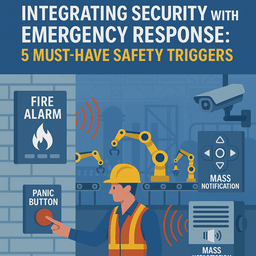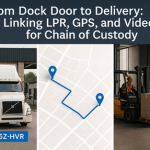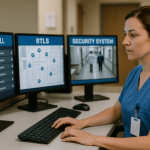
In the manufacturing world, every second counts during an emergency.
A fire outbreak, unauthorized access, chemical spill, or medical emergency can spiral out of control if the right people aren’t alerted at the right time. While most plants have standard safety systems in place, many overlook the critical integration between physical security systems and emergency response protocols.
The result? Slower reactions, miscommunication, and avoidable downtime—or worse, injury.
This post covers five essential safety triggers that manufacturing facilities should integrate into their broader security ecosystem—to ensure a faster, more coordinated, and more effective emergency response.
k
k
🔄 Why Integration Matters: Security and Safety Are Two Sides of the Same Coin
Traditionally, safety systems (like fire alarms or emergency exits) and security systems (like access control or video surveillance) have been siloed. But in today’s high-risk industrial environments, integration isn’t optional—it’s essential.
When a fire alarm goes off, do your access doors automatically unlock for evacuation?
When a panic button is pressed, do you have video and location data instantly available?
By connecting systems—access control, surveillance, mass notification, intercoms, and emergency alerts—you create a real-time response network that protects workers, assets, and operations more effectively.
k
k
✅ Trigger #1: Fire Alarm Activation Unlocks Egress Paths and Sends Alerts
A fire alarm system must do more than sound a siren. Modern safety integration allows your fire panel to:
-
Automatically unlock all emergency exits and relevant doors
-
Trigger strobe lights and voice evacuation instructions
-
Send real-time alerts to plant supervisors, EHS teams, and first responders
-
Bookmark video surveillance footage of impacted zones
This ensures rapid, unblocked evacuation while providing visibility into exactly where the threat originated.
Pro Tip: Work with your access control provider to ensure door release protocols comply with local fire codes and NFPA standards.
k
k
✅ Trigger #2: Duress Button Signals Security and Records the Event
Duress buttons, often overlooked, are critical for personal safety. When activated, they should immediately:
-
Send a silent alert to the control room or off-site monitoring team
-
Tag the associated camera feed for instant visual verification
-
Log the user ID, location, and time of activation
-
Optionally trigger lockdown of nearby zones
This allows for a stealthy but swift response to active threats, altercations, or harassment incidents.
Use Case Example: A receptionist sees an aggressive intruder approaching the lobby. She hits a duress button under the desk—alerting security while locking the entrance doors and triggering cameras without escalating the situation.
k
k
✅ Trigger #3: Access Denial in Restricted Areas Sends an Alert
When a badge is denied at a restricted door (e.g., chemical storage, server room), that shouldn’t be a dead-end event. With proper integration, this denial can:
-
Send an alert to facility security or management
-
Trigger video recording for investigation
-
Start an automated workflow—such as locking nearby doors or notifying a supervisor
This turns failed access attempts into proactive alerts, allowing security teams to detect potential threats or tailgating attempts in real time.
Bonus: Integrate with HR systems to automatically adjust badge permissions based on role, training, or shift.
k
k
✅ Trigger #4: Environmental Sensors Activate Security Protocols
Many manufacturing environments contain sensors for:
-
Gas leaks
-
Water intrusion
-
Temperature thresholds
-
Air quality (e.g., particulate levels in paint booths)
When these sensors are triggered, don’t just send a facility alarm. The event should also:
-
Trigger surveillance cameras in the affected area
-
Send alerts via mass notification (text, email, radio)
-
Lock down high-risk zones to prevent entry
-
Alert the EHS team with sensor data and timestamps
By connecting your environmental systems with security infrastructure, you move from passive alerts to automated, safety-driven action.
k
k
✅ Trigger #5: Mass Notification System Tied to Security Events
Whether it’s a tornado warning or an active shooter, how quickly you notify your workforce matters. A modern mass notification system should be able to:
-
Send facility-wide messages across multiple platforms (text, intercom, email, signage)
-
Be automatically triggered by access events, panic buttons, or surveillance anomalies
-
Provide specific instructions per zone (e.g., evacuate, shelter-in-place, avoid Area 3)
Speed and clarity save lives—and mass notification tied to your security stack ensures both.
k
k
🔧 How to Get Started: Steps to Integrate Security and Emergency Response
You don’t need a full system overhaul to begin integrating security with safety. Start here:
-
Audit your existing security and safety systems
-
Identify what’s already in place and what systems talk to each other.
-
-
Pinpoint key risks and failure points
-
Think about worst-case scenarios. Where would faster alerts or smarter automation help?
-
-
Work with an integrator (like SSP)
-
A security integrator can help design a unified system tailored to your plant layout and risk profile.
-
-
Test scenarios and train staff
-
Run live drills that involve integrated responses—train your people, not just your tech.
-
k
k
🏁 Final Thoughts: Protecting People, Property, and Production—Together
In manufacturing environments, safety incidents and security breaches often overlap. A gas leak can require access control. A visitor altercation can spark a panic event. A fire alarm may need instant video confirmation.
That’s why integrating security with emergency response is no longer a “nice-to-have.” It’s a business-critical investment in your people and your plant.
👉 Want to explore how to integrate safety triggers into your facility’s security system?


